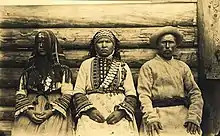Besermyan
The Besermyan, Biserman, Besermans or Besermens (Russian: бесермяне, besermyane singular: besermyanin, Udmurt: бесерманъёс, Tatar: бисермәннәр, romanized: bisermännär) are a numerically small Permian people in Russia.[2]
 | |
| Regions with significant populations | |
|---|---|
| Udmurtia (Russia) | |
| 2,201 (2010)[1] | |
| Languages | |
| Udmurt (Besermyan dialect) | |
| Religion | |
| Majority: Sunni Islam Minority: Russian Orthodoxy | |
| Related ethnic groups | |
| Other Permians Especially Udmurts | |
The Russian Empire Census of 1897 listed 10,800 Besermans. There were 10,000 Besermans in 1926, but the Russian Census of 2002 found only 3,122 of them.[3]
The Besermyan live in the districts of Yukamenskoye, Glazov, Balezino, and Yar in the northwest of Udmurtia. There are ten villages of pure Besermyan ethnicity in Russia, and 41 villages with a partial Besermyan population.
History
The Besermyan are of Turkic origin,[4][5] and are probably the result of a group of Volga Tatars who were assimilated by the Udmurts.[6][7][8] In the 13th century during his travel to Mongolia, papal envoy Plano Carpini claimed that the Besermyan were subjects of the Mongols. Russian chronicles sometimes made mention of the Besermyan but it's unclear whether the term was meant to denote the modern group as it was a common derivation of the term "musulman" (Muslim).[4] It is likely that the term had broader usage before it became an ethnonym.[4]
Culture
The language of the Besermyan is a dialect of the Udmurt language with Tatar influences.[6] Although they speak a dialect of Udmurt, the Besermyan consider themselves a distinct people.[9]
Some Besermyan traditions differ from other Udmurtian customs due to the Islamic influence during the Volga Bulgaria and Khanate of Kazan periods.
The Besermyan used to historically practice their own indigenous religion.[2] According to scholar Shirin Akiner, most current Besermyan practice Sunni Islam.[4] Some Besermyan also practice Christianity.[9] The Russians began converting the Besermyan to Christianity around the middle of the 18th century.[2]
References
- Официальный сайт Всероссийской переписи населения 2010 года. Информационные материалы об окончательных итогах Всероссийской переписи населения 2010 года [Official site of the National Population Census 2010. Informational materials about the final outcome Russian Census 2010] (in Russian). RU: GKS.
- Bondarenko, Dmitri; Kazankov, Alexander; Khaltourina, Daria; Korotayev, Andrey (2005). "Ethnographic Atlas XXXI: Peoples of Easternmost Europe". Ethnology. 44 (3): 262. doi:10.2307/3774059. ISSN 0014-1828. JSTOR 3774059.
- demoskop.ru: Alphabetical list of peoples of the Russian Empire Archived 2012-02-05 at the Wayback Machine
- Akiner, Shirin (1986). Islamic Peoples Of The Soviet Union. Routledge. p. 103. ISBN 978-1-136-14266-6.
- Sinor, Denis (1988). Handbuch Der Orientalistik. BRILL. p. 765. ISBN 978-90-04-07741-6.
- Olson, James Stuart; Pappas, Lee Brigance; Pappas, Nicholas Charles (1994). An Ethnohistorical Dictionary of the Russian and Soviet Empires. Greenwood Publishing Group. pp. 104–105. ISBN 978-0-313-27497-8.
- Wixman, Ronald (2017-07-28). Peoples of the USSR: An Ethnographic Handbook. Routledge. p. 27. ISBN 978-1-315-47540-0.
- Dalby, Andrew (2015). Dictionary of Languages: The definitive reference to more than 400 languages. Bloomsbury Publishing. p. 324. ISBN 978-1-4081-0214-5.
- Bremmer, Ian; Taras, Ray (1996). New States, New Politics: Building the Post-Soviet Nations. Cambridge University Press. p. 180. ISBN 978-0-521-57101-2.
- kominarod.ru: Бесермяне (in Russian)
- "Bisermän". Tatar Encyclopaedia (in Tatar). Kazan: The Republic of Tatarstan Academy of Sciences. Institution of the Tatar Encyclopaedia. 2002.